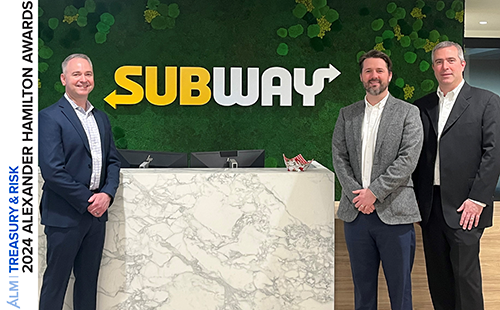 Volatility in the foreign exchange markets has become a greater concern for finance professionals over the past year, according to the annual risk survey released by the Association for Financial Professionals.
Volatility in the foreign exchange markets has become a greater concern for finance professionals over the past year, according to the annual risk survey released by the Association for Financial Professionals.
Thirty percent of the 335 finance professionals whom the AFP surveyed listed currency risk as one of their top five concerns, up from just 16% who cited it as a top concern in last year's survey. Currency risk was the fourth-highest–ranked concern in the 2016 survey, following only political and regulatory uncertainty, which was cited by 43%; tougher competition (42%); and customer satisfaction and retention (40%).
“It's interesting that currency volatility made it into the top five for the first time,” said Craig Martin, executive director of AFP's Corporate Treasurers Council. “The hit to earnings from currency translation losses has certainly been a factor in multinationals' earnings for well over a year now.”
Martin noted that more and more U.S. companies have begun to operate internationally over the past five years. “It's new to them, and they've found themselves in a much more difficult position, especially with the shifts going on in the global economy,” he said.
More than half (52%) of the respondents said their company faces greater earnings uncertainty now than it did three years ago, and the most frequently cited driver was financial factors including interest rates and currencies.
In the AFP survey, 54% of respondents said their companies has a hedge program in place to deal with interest rate, FX, or commodity risks, and 24% said they are beginning to implement a hedge program.
Martin said that given the extent of the volatility in financial markets, the proportion of companies with hedge programs in place is “disappointingly low.”
Revamping Hedging Programs
Amol Dhargalkar, a managing director at financial risk management company Chatham Financial, said he's seen “a pretty significant number of companies that are really looking to revamp their existing [hedging] programs.”
A survey of 350 executives which Chatham conducted during a recent webinar showed that about a third of companies are considering making improvements in their hedging programs over the next six months, he said. Those programs hedge FX, interest rate, and commodity exposures.
“Certainly on the FX side, we've seen a lot of companies trying to move into different ways of hedging their exposure,” Dhargalkar said.
One area companies are looking at is translation risk, which involves the effect of foreign exchange movements on a company's balance sheet as foreign business units' financials are translated into the parent company's functional currency. “We've worked with a number of companies that are very focused on that translation impact of the dollar strengthening,” he said.
One of the biggest problems is that companies can't use hedge accounting if they hedge translation risk.
Given that obstacle, “there might be different strategies that a company can apply from a hedge that can mimic translation hedging,” Dhargalkar said. “That's something we've spent a lot of time with clients around.
“I'd say a pretty low percentage of companies today are doing [translation hedging], but it's a higher percentage today than it was a year ago and much, much higher than two years ago,” he added.
The AFP survey showed that among companies hedging interest rates, swaps are the most popular instrument, while forwards are used most frequently to hedge FX risks. The report also cited increased interest in using options to hedge financial risks.
But Ryan Gaylor, vice president of client sales and midmarket at Reval, a provider of treasury and risk management solutions, said the appeal of options has faded.
“The longer the volatility persists and trends in a single direction, the more that volatility is priced into the premiums of the options, which then makes them less favorable,” Gaylor said. “In general, most corporates prefer using straight forwards.”
Commodity Risk
Dhargalkar noted companies' concern about commodities prices, with almost a third of the executives surveyed during Chatham's webinar citing commodity price volatility as their highest concern.
“We actually have seen a lot of companies try to dig into their commodities exposures,” he said. “One of the challenges is the commodity exposure may be managed, not necessarily within treasury but maybe within the procurement function.”
The most important thing is for companies to get a handle on their exposures, Dhargalkar said.
“For those companies that aren't hedging their commodity risk but know they have a significant amount of commodity risk, that's where to start,” he said. “Get everyone in the room and decide how you can take advantage of the prices where they are now.”
Reval's Gaylor said that many corporates find it more difficult to implement a commodity hedging program than programs to hedge other asset classes, such as currency and interest rates. There is more complexity, including collateral management, counterparty risk and cost basis. In addition, “overall, it's harder to prove out the effectiveness of that hedge,” he said. But Gaylor noted that a revised international accounting standard, IFRS 9, and a tentative Financial Accounting Standards Board decision on component hedging, may make it easier to prove the effectiveness of commodity hedges.
“There's a number of different customers that have been looking at commodity hedging programs for a while,” Gaylor added, and said that with commodity prices at low levels, “for those seeing a benefit from low commodity prices, now is a great time to put that [hedge] on.”
© 2025 ALM Global, LLC, All Rights Reserved. Request academic re-use from www.copyright.com. All other uses, submit a request to [email protected]. For more information visit Asset & Logo Licensing.




